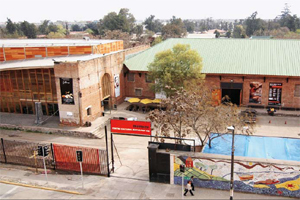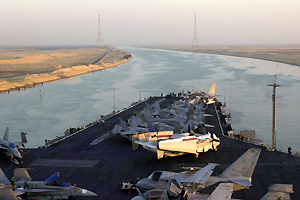The public works thought up for this celebration correspond to initiatives promoted by the president of the Republic, which will improve the infrastructure of Chile’s cities, and thanks to that, the quality of life of the citizens will improve.
The works, projects and programs also contemplate initiatives of intangible value. For example, they include artistic and cultural events and gatherings. They are nationwide activities -even though they might take place at a specific location- because they have an impact on the entire community because of their historical relevance for example.
A few noteworthy works, projects and programs are the following:
– Gabriela Mistral Cultural Center: this Bicentennial Project seeks to open up the doors of the former Diego Portales building so the entire community can access a first level cultural space. This way, the intention is to recover the original idea of the creators of this building.
The Gabriela Mistral Cultural Center will be a place for the promotion and development of cultural expressions, such as performing or visual arts or music. Likewise, it will be the foundation of a national network of places promoted by the National Council of Culture and the Arts.
– Bike Route Master Plan: it is a network of routes for bike riders, the objective of which is to lower pollutions levels in the capital and provide safety for those that choose to commute by bicycle. It is expected to be completed by the year 2012 with a total of 690 kilometers of bike routes.
Of this total, 550 kilometers will be in the urban area of the city and 140 will be in rural areas. This plan also contemplates the implementation of a network of 200 parking spaces for bikes. It is expected that by the year 2010, when the Bicentennial is celebrated, the Bike Route Master Plan will already have 100 parking spaces.
The project is a joint effort between the ministries of Housing and Urban Planning, Public Works and Transportation and Telecommunications.
The regional government is also involved, among others.
– Eco Cultural Quebrada Verde: this project will be made around 10 km south of Valparaiso and the objective is to create an outdoor space for the community. It will span 100 hectares of the Quebrada Verde estate, land that was handed over to Valparaiso in 1915 by Federico Santa Maria and which is presently property of the National Healthcare Fund (Fonasa).
This way, the portside municipality, the regional government and the universities, among other social participants, are working to make this a great park that becomes a place where citizens can participate and express themselves, also promoting a culture that is in touch with the environment.
– Ciudad Parque Bicentenario (Bicentennial Park City): this is probably the most important urban project ever developed in the country. It is expected that by 2010, a central park open to the public should be built, as well as ten full residential neighborhoods.
This project will cover 250 hectares located in the south western part of the capital. Specifically, between Departmental, General Velazquez, Lo Errazuriz and Pedro Aguirre Cerda Avenues, in the area that used to house Los Cerrillos airstrip.
The project is being spearheaded by the Ministry of Housing and Urban Planning and its main goal is to establish a method that brings together the public and private sectors to create modern neighborhoods that benefit quality of life and community living for different types of families.
What will be included in the Bicentennial Park City? There will be 70 hectares of green areas. Of these 70, 50 will be a huge central park and the rest of the surface will make up side parks, walkways and open spaces for practicing sports, for example. In addition, there will be a two hectare sailable lagoon.
But that’s not all, there will also be buildings, housing, schools, supermarkets, cultural areas, public services, stores, firemen and a civic center for the comuna (county), which will house the city hall building of the Municipality of Cerrillos.
A few Bicentennial projects that have already been inaugurated
– Chacalluta Airport: it is located in Arica and has a surface area of 5,200 m2, two mobile boarding bridges, full airport equipment, parking and foot traffic area
– Restoration and commissioning of the Humberstone and Santa Laura saltpeter works: this project was done in order for the region of Tarapaca to have an excellent tourist destination, recreating the heyday of saltpeter in the country.
The project included the fortification of the offices and the construction of infrastructure that provides safety.
– Recovery of the shores of Antofagasta: the abundance of rockeries and the absence of important natural beaches in a great portion of the Antofagasta coast brought on the need to carry out a plan to commission artificial beaches, a long awaited wish of the community. Highlights are the Municipal Bathing Area, with maritime and architecture work, Costanera Norte avenue, a bike route and a foot traffic sidewalk that is connected to different shore side promenades.
– Recovery of the Wheelwright promenade in Caldera: work performed on the city side shore of this city that incorporates elements related to culture, entertainment and recreation in general. It connects the bay with the old hull of the port, making up a heritage filled place.
– Coquimbo Small Scale Fishing Port: it came about along with the recovery of the comuna’s (county’s) small scale fishing and tourist shores. Its upkeep is the responsibility of the Fishermen’s Union of Coquimbo.
– Route 60 Ch Los Libertadores Corridor (region of Valparaiso): it is a bioceanic corridor made to promote the integration of the neighboring regions, bringing the ports of the central zone of Chile closer to the ports of the Atlantic ocean through the Los Libertadores International Crossing.
– Remodeling of the Plaza de Armas of Talca: it included the redesign of the irrigation grid and the replacement of the pavement and lighting. It also contemplated repairing the urban infrastructure (trash cans and the central kiosk, among other things) to improve the quality of life of one of this city’s main meeting points.
– Maule Regional Theatre: it has a seating capacity of 1,066 and has a hall for mounting exhibitions and ceremonies that can fit 500 people. In addition, the venue has a conference space with a capacity of 60 people.
The intention behind this theatre, considered to be one of the best in the country, is to promote the work of regional and national artists.
– Eje Bicentenario (Bicentennial Axis): it is found in the city of Concepcion and it includes the Bicentennial Plaza, a hectare wide esplanade filled with water mirrors, lighting and trees around the Civic District. It is connected to the park that joins the city and the Biobio river and goes all the way to the Regional Government building (the former Concepcion Railway Station).
– Pablo Neruda National Railway Museum: it is located in the Casa de Maquinas (Machine House) of Temuco and has several cars and locomotives that have been national monuments since 1989, and since 1998, they have been on a waiting list to make them World Heritage.
– Libertad Promenade: it is found in the urban area of Valdivia and links tourism with the commercial activities that take place along the shores of the Calle Calle river. It spans 700 m2 and includes new urban infrastructure (benches, trash cans, etc.).
– Far South Fiber Optic Grid in the region of Aisen: it is 830 km long and was developed as a Bicentennial project because its installation was not cost effective for private entities. The scope includes extending the main fiber optic national line from Puerto Montt.
– Punta Arenas Bypass: it is a stretch of highway, a promenade and a bike route that includes a bird observatory and sculptures made following the theme of the zone’s native cultures.
Bicentennial Seal
It is a symbolic recognition that is handed out by the Bicentennial Commission to initiatives that come from society, be it from the public or private sector, and its objective is to contribute to the identity and of the nation and build a better country at the brink of completing 200 years of Republican life in Chile.
The projects that are awarded the Bicentennial Seal must be within the value system and spirit of this celebration.
The Bicentennial Commission has a wide ranging group made up by organizations that provide support in the task of identifying projects that fall within the aforementioned ideals. The members are Accion RSE, the Committee for the Promotion of Solidarity, Comunidad Mujer (Woman Community), Production and Trade Confederation, Cultural Heritage Corporation, Innovation and Citizenry Corporation, Chiledeportes, Fondart, PROhumana Foundation, Foundation for Overcoming Poverty, Paz Ciudadana Foundation, Pro Chile, Prodemu, Avina Foundation, Teleton Foundation, the small Subsidies Area of PNUD Chile and FUCOA.








